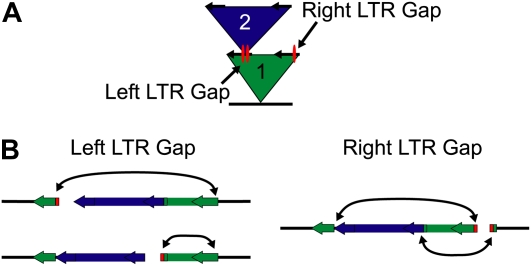Figure 2.
Nested LTR retrotransposons cause sequence assembly gaps. Diagram of the commonly seen type of gap caused by nested LTR retrotransposons. A, Nested TE insertion view of the gap region. The blue TE (labeled 2) is found nested within the LTR of the green LTR retrotransposon (labeled 1). This can cause an assembly gap in one of three locations: at the insertion point of the blue TE on either the left or the right of the insertion, or on the other LTR of the green TE at the corresponding location of the insertion point. B, A sequence view of the three gap locations caused by insertion of the blue TE into the LTR of the green LTR retrotransposon. The blue TE has inserted into the left LTR of the green TE, and an assembly gap can be found on the left LTR to either the left or the right of the blue TE insertion. In either case, the sequence of the left LTR of the green TE has been split apart, and sequences belonging to the right LTR have incorrectly assembled at this split location (shown as the arrow pointing to the red sequence) and cause the gap assembly. The assembly gap can also occur on the right LTR of the green TE. Here, the join sequences between the left LTR and the blue TE, found on both sides of the blue TE insertion, can assemble incorrectly into the sequence of the right LTR and prevent the sequence from aligning. Successful closing of these types of gaps is crucial to characterization of maize nested repeat clusters.

